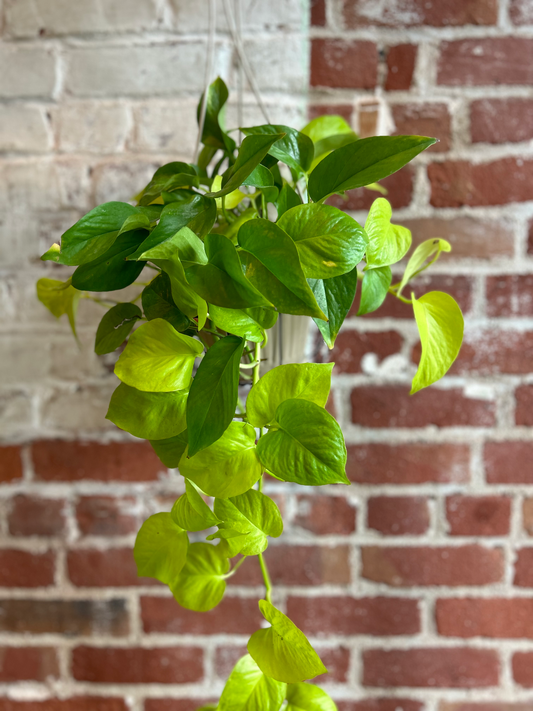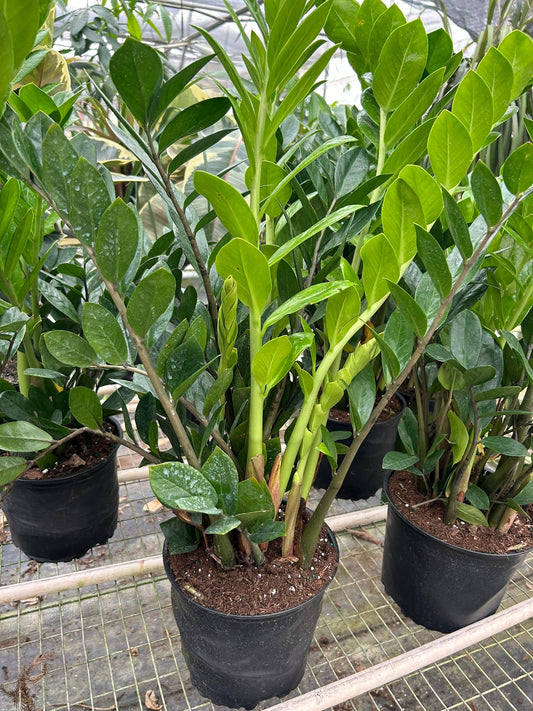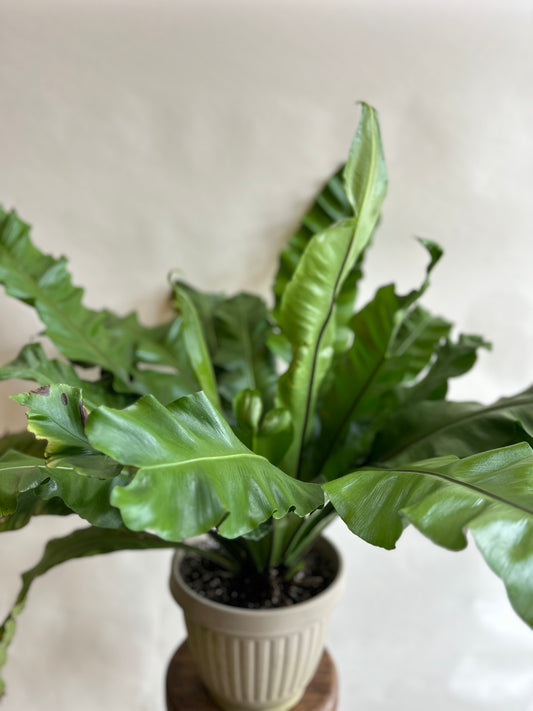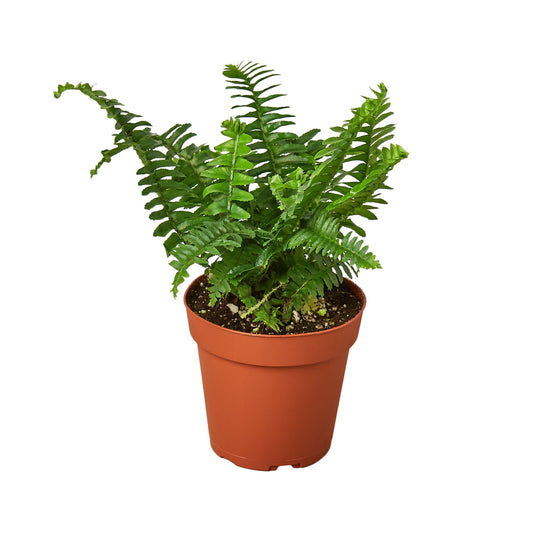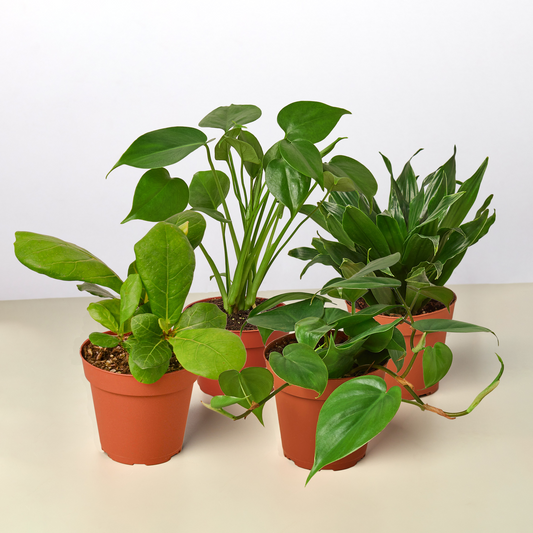What is the Best Soil Type for Mauna Loa Peace Lilies?
Cafe Planta Team
Peace Lilies, especially the Mauna Loa variety, are beloved by many plant parents for their striking, glossy leaves and elegant white blooms. But if you've ever struggled to keep your Peace Lily looking its best, you're not alone. One of the most important factors for their health is getting the soil just right.
In this post, we'll chat about what makes the best soil for Mauna Loa Peace Lilies, touching on everything from soil composition to moisture levels. Whether you're a seasoned plant lover or just starting your green-thumb journey, you're in the right place to learn how to help your Peace Lily thrive.
Understanding Your Mauna Loa Peace Lily
Before we get into the nitty-gritty of soil types, it's worth taking a moment to understand what makes Peace Lilies tick. These tropical plants are native to the rainforests of Central and South America, where they naturally grow under the canopy of taller trees. This environment offers them a rich, loose soil, plenty of moisture, and filtered sunlight.
In your home, the Mauna Loa Peace Lily aims to replicate that cozy, tropical environment. It’s a plant that thrives on neglect in some ways but can be surprisingly fussy about its living conditions, particularly when it comes to soil and watering. If you’re seeing yellowing leaves or droopy stems, it might be time to check what’s happening beneath the surface.
So, what kind of soil do these tropical beauties prefer? Essentially, it needs to mimic their natural habitat, which means a mix that retains moisture but doesn’t get waterlogged, allowing for good drainage and aeration.
The Importance of Soil Composition
Let's talk about what makes up a good soil mix for Mauna Loa Peace Lilies. The right composition encourages healthy root growth and ensures that your plant drinks just the right amount of water. Here’s what you should look for:
- Organic Matter: This is the material that holds moisture and provides nutrients. Think peat moss or coconut coir. These components are excellent for retaining water without becoming swampy.
- Drainage Elements: Perlite or sand can help improve drainage. You don't want your Peace Lily sitting in a soggy mess, as this can lead to root rot.
- Aeration: Adding components like orchid bark or pine bark chips can help create air pockets within the soil, which is essential for root health.
Combining these elements in the right ratios is the secret sauce to a happy Peace Lily. A good rule of thumb is to aim for a mix that feels light and airy yet retains enough moisture to mimic that rainforest floor.
DIY Peace Lily Soil Mix
If you're the DIY type, creating your own soil mix can be a rewarding project. Plus, it gives you complete control over what goes into your plant's home. Here’s a simple recipe:
- 40% peat moss or coconut coir
- 30% perlite
- 20% orchid bark
- 10% compost or worm castings for nutrients
Mix these ingredients together thoroughly. You’ll want to avoid any large clumps of material that could hinder water flow. The result should be a mix that feels moist yet crumbly—a bit like a well-made cake!
While this concoction is a great starting point, feel free to tweak the ratios based on the specific needs of your home environment. If your plant feels a bit too dry, you can increase the peat moss. If it's staying too wet, add more perlite or bark.
Pre-Made Soil Mixes
Not everyone has the time or inclination to make their own soil mix from scratch, and that's perfectly okay! There are plenty of high-quality, pre-made mixes available that are suitable for Peace Lilies. When choosing a pre-made mix, look for those labeled as suitable for "houseplants" or specifically "aroids." These will often contain a balance of the components mentioned earlier.
Some popular brands offer mixes that include added nutrients, which can be a bonus. However, always check the bag for ingredients like slow-release fertilizers to make sure they align with your feeding schedule.
It’s worth noting that while these mixes are convenient, they might still need a little tweaking. If you find the mix a bit heavy, consider adding more perlite or orchid bark to improve drainage. The goal is to create a happy medium where your Peace Lily can comfortably grow.
Repotting Your Peace Lily
Once you've got the perfect soil mix, the next step is repotting your plant. This process can seem daunting, but it's actually quite straightforward. Here’s how you can do it:
- Select the right pot: Choose a pot that's one size larger than the current one. Make sure it has drainage holes to prevent waterlogging.
- Prepare the new pot: Fill the bottom with a layer of rocks or broken pottery pieces to further aid in drainage, then add some of your soil mix.
- Remove the Peace Lily: Gently take your plant out of its current pot. You might need to squeeze the sides to loosen it up.
- Examine the roots: Check for any signs of rot or overly dense root balls. Trim any unhealthy parts with sterile scissors.
- Settle in the new pot: Place the plant in its new home and fill in around it with more soil. Press down lightly to remove air pockets but avoid compacting the soil too much.
- Water thoroughly: Give your Peace Lily a good drink to help it settle in. Make sure the water drains out from the bottom.
After repotting, your Peace Lily might seem a little off for a week or two. This is normal as it adjusts to its new environment. Keep an eye on it, and soon enough, you should see fresh growth as a sign of its contentment.
Watering: The Balancing Act
Watering is a major part of caring for a Mauna Loa Peace Lily. These plants like their soil to be consistently moist but not drenched. It’s a bit like getting a sponge just right—not too dry, not too drippy.
A good way to check if your Peace Lily needs water is to stick your finger about an inch into the soil. If it feels dry, it’s time for a drink. If it’s still moist, hold off a bit longer. Overwatering is a common mistake and can lead to root rot, so it’s better to lean towards underwatering if you’re unsure.
When you do water, do so thoroughly. Let the water run through the soil and out the drainage holes. This flushes out any salts that can build up from fertilizers and ensures that all parts of the soil are hydrated. Just remember to tip out any excess water from the saucer to prevent the roots from sitting in it.
Signs of Soil Trouble
Even with the best intentions, sometimes things go awry. Here are some signs that your Peace Lily’s soil might not be up to snuff, and what you can do about it:
- Yellow leaves: This often indicates overwatering. Check your soil's moisture levels and adjust your watering schedule or improve drainage.
- Droopy leaves: While this can be a sign of underwatering, it can also mean your plant's roots are suffocating. Make sure your soil mix is well-aerated.
- Moldy soil: This is a clear sign of poor drainage and excess moisture. Consider repotting with a better soil mix and ensuring your pot has adequate drainage.
Addressing these issues promptly can help nurse your plant back to health. Sometimes, a simple change in soil can make all the difference to your plant’s well-being.
The Role of Humidity
In addition to soil and watering, humidity plays a significant role in keeping your Peace Lily happy. Remember, these plants hail from humid rainforests, so they do appreciate a bit of extra moisture in the air.
If the air in your home is particularly dry, especially in winter, consider placing a humidifier nearby or setting your plant on a tray of pebbles with water. This can help replicate their natural environment and prevent the edges of the leaves from browning or curling.
Misting the leaves can also be beneficial, but be cautious not to overdo it—wet leaves can be a breeding ground for mold and mildew. A gentle spritz every few days should suffice.
Final Thoughts
Getting the soil right is crucial for your Mauna Loa Peace Lily's health. By focusing on a balanced mix that provides both moisture retention and excellent drainage, you're setting the stage for a thriving plant.
At Cafe Planta, we love helping plant people like you create beautiful, thriving plant collections. If you have questions about plant care or need advice on choosing the right plant, feel free to email us or send a DM on Instagram. Whether you're an experienced plant parent or just starting out, we're excited to be part of your plant journey!


